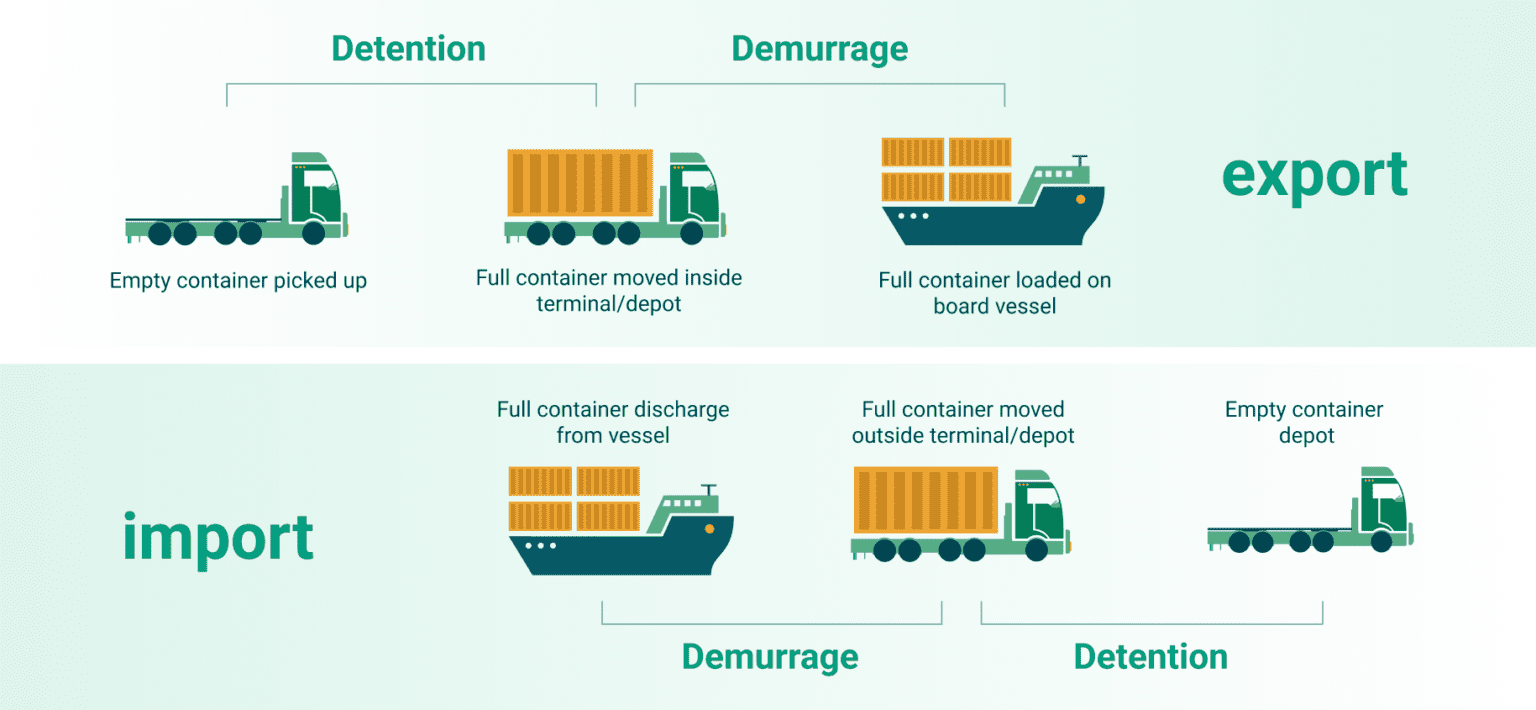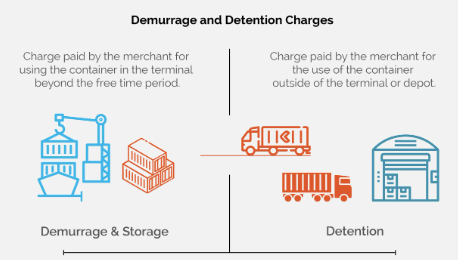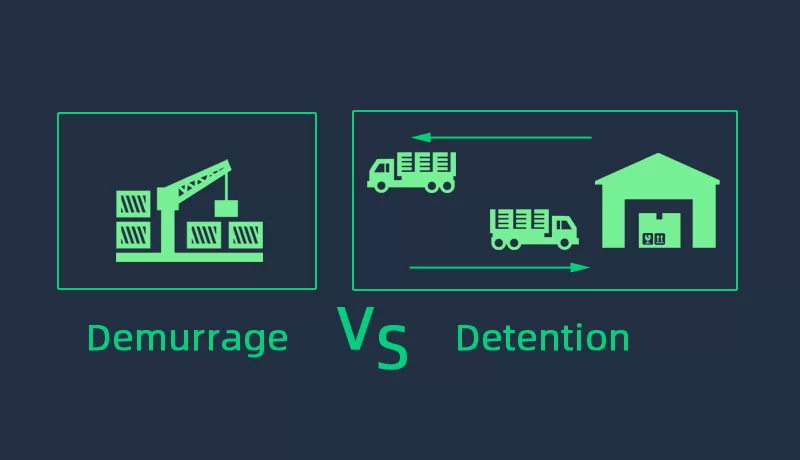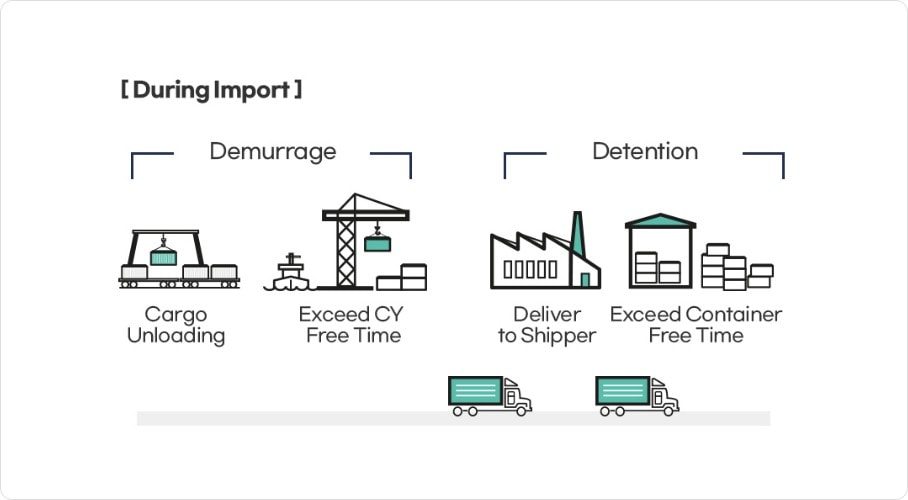
Meta Description: Get to know the main distinction between detention fees, ramp and detention charges, and demurrage and detention charges in shipping. Learn the tricks of preventing such expensive fines as suggested by professional freight forwarding agents and logistic services providers.

There is a lot that can go wrong when it comes to international shipping and knowing what your priorities should be when it comes to extra costs charged that can easily consume your profit margins. Detention and demurrage are two of the most misinterpreted, and at the same time extremely important shipping terminologies where you can also charge detention fees . The charges may impose huge expenses on your shipping operations without proper management hence it is important to know the differences and implications of these charges as a logistical professional or an importer or an exporter.
What Are Detention and Demurrage Charges?

Detention and demurrage are charges represented by the shipping lines and terminal operators when the cargo containers are kept after they were given their free time. Although the two charges are used to encourage efficient flows of the cargo, the two charges relate to two different stages of the shipping process, and their features also differ and influence calculations and the manner of managing both charges detention fee.
These charges are provided specifically to facilitate smooth running of the ports and of shipping lines through the incentive of prompt cargo movements. Such penalties would not be in place and that cases would occur where containers pile up at terminals and consignees detention refers, which creates a bottleneck that would greatly affect the efficiency of global trade.
The Fundamental Difference Between Detention and Demurrage

The major difference between detention and demurrage is the place of a container that is in when the charges start accruing. Demurrage charges come into force when the containers stay at the port or terminal after the time of staging the containers is over, and the free days for detention charges are incurred when containers have been withheld by the consignee or his representative outside the precincts of the terminal container freight station.

The management of cost and logistical planning highly depends on their understanding of this location-related difference legal driving hours. Every type of charge comes with varying effects on your supply chain activities and will need various approaches in prevention and counteraction container yard.
Understanding Demurrage Charges in Detail

Demurrage fees are paid in case of import shipment containers, which are staying at the port terminal longer than the free time defined. Such free time is normally between 3 and 7 days, which affects the demurrage and detention fees, and varies according to the particular terminal, shipping line, as well as local government regulations. The charge is supposed to promote on-time pick-up of cargo and avoid congestion at the terminals.
The demurrage rates are normally computed in a tier manner whereby the charges levied rise with the number of days taken to move the container out of the terminal. An example would be that the initial few days could be charged at a lesser rate whereas the charges would increase with subsequent days.
Detention Charges Explained

After one of the containers is discharged out of the terminal and not retreated after free period of time, container detention charges start accumulating. This fee reimburses the shipping line on the exceptional use of their equipments other than the normal turnaround period. The common time a container spends on detention begins at the point of being picked up at the terminal and ends after the container is then delivered empty.
In contrast to demurrage, detention charge accrues to follow the container wherever it is during shipment whether it is at the facility of the consignee or in a warehouse, or even in transit. This complicates the management of detention because a number of stakeholders in the supply chain are required to come together.
Key Differences in Calculation Methods

The calculation methodology used to determine demurrage and detention charges are quite dissimilar and represent the dissimilar functions. The calculations of demurrage are usually simple and it entails multiplying the number of days the container was in a terminal with the daily rate. A majority of the terminals work under a sliding scale where fees charged are high beyond specific limits.
Calculations of detention may be more complicated and may include variable rates on weekdays and weekends and holidays due to time spent detained . There are also shipping lines with combined free time of pick up and return and those which count them independently. These nuances should be grasped to get the cost forecast right.
Free Time Periods and Variations

Periods of free time differ greatly depending on a number of factors such as shipping line, rail storage charges destination port, container shipment, and local regulation. The allowed time that is given free days at the terminal to an import container is 3-7 days, whereas the export container can be allowed various days. The free time arrangements may vary between full container loads (FCL) and less than container loads (LCL) very frequently.
Calculations of free time may be subject to special circumstances including the weekend, holidays, and the force majeure. At some terminals these periods are not included into free time calculations whereas in other terminals they are. Planning and cost management requires one to understand such variations.
Common Scenarios Leading to Detention Charges
There also exist certain broad situations that can cause detention charge that need to be familiarized by importers and exporters. The most common occurrence of holding period and this happens to be delaying containers in customs, documentation problems, payment problems as well as inspection necessities. Poor warehousing facility or booking problems too can add to detention charges.
These problems can be exacerbated by seasonal aspects like high times in shipping or holiday approaches in a local area. Knowledge of such scenarios assists towards devising advance measures of avoiding detention and potential costs incurred.
Typical Demurrage Situations
The common causes of occurrence of demurrage charges are inadequate terminal space, strike action, weather related problems and/or need to scrutinize cargo. Containers may also be left in terminals past the free times due to customs hold, quarantine inspection, and discrepancies of documents.
Another major cause of demurrage charges is port congestion at the peak seasons. Operating the terminals at maximum capacity can result in delays even of routine operations extending the containers beyond their free time quotas.
Impact on Supply Chain Operations
The cost of detention and demurrage fee in addition to direct costs of detention and demurrage charges can also have serious effects on the supply chain operations. These fees usually point to some logistics inefficiencies that may directly influence delivery time in a timely manner , inventory, and customer experience.
It may even make it difficult to budget and plan finances because these charges are unpredictable. There is a high possibility of penalty charges that the companies need to consider in terms of total landed costs and pricing strategies which makes it difficult to forecast properly.
Legal and Contractual Considerations
The terms and conditions that guide detention and demurrage charges are normally based on the bill of lading and terminal tariffs. These are papers which specify free time allowances, charge rates and the calculation methods. The appreciation of these contractual obligations is key to resolving dispute and negotiation.
These charges can also be regulated differently under different jurisdiction with recent legal processes aiming at making the charges more transparent and fair. The compliance and the ability to control costs are important reasons to be aware of regulatory changes.
Strategies for Avoiding Detention Charges
To avoid detention fees and to charge to avoid demurrage, avoiding it involves proper planning and good logistic operations. Such methods are preparation of proper documentation beforehand, coordination with customs brokers and terminal operators, having sufficient warehousing and transportation capacity.
Technological tools like containers tracking systems, automated notification, and online documentation systems could greatly benefit efficiency and minimise detention expenses. Open communication with all the stakeholders within the supply chain is also essential in resolving the problems in time.
Preventing Demurrage Charges
Demurrage prevention aims at picking up the cargo on time in terminal gates. This consists in the coordination with trucking companies, customs brokers and warehouse operators with the purpose to reduce delay and avoid paying demurrage . Alternate mode of transport, backup transportation communications, and leeway in the schedule would be beneficial to deal with unforeseen delays.
By keeping an eye on the performance of terminals and being aware of the possible disruption like strikes or bad weather, one has the possibility to plan ahead. It will also help to find solutions to any problem faster because the relationships with the terminal operators should be established and clear communication lines must be maintained.
Cost Management and Budgeting
Cost-effective controlling of costs on detention and demurrage charges should be based on proper forecasting and contingencies planning. Firms ought to study their past data in order to define trends and possible risk issues. It is wise to create some buffer time in the logistics timelines and have extra money at hand in case of untold expenses.
Contracts with shipping lines and these are the terminal operators should be negotiated and revisited regularly to make the best of terms and also limit possible charges. Knowledge of the complete cost structure and other possibilities like merchant haulage can give more cost management possibilities.
Technology Solutions for Tracking and Management
There are many solutions to detention and demurrage runners to deal with modern technology. Container tracking systems allow real-time monitoring of the status and position of containers, which lets one make proactive decisions. The approaching free time deadlines can be informed to stakeholders by means of automated alert systems.
Documents will be simplified thanks to digital platforms, which are particularly integrated with terminal and shipping line systems, and facilitate the elimination of delays. The technologies of artificial intelligence and machine learning are gradually finding their application in predicting possible delays and streamlining logistics work.
Industry Best Practices
The good practice in the industry involves recognition of communication protocols, accompanying documentation, as well as implementation of sound tracking systems in management of detention and demurrage charges. Training of employees on the existing policies and procedures should be regularly carried out to ensure they are up to date.
Establishing good relations with the service providers such as the freight forwarders, customs brokers, and terminal operators can also be helpful in dealing with such charges. It is also useful to be a member of industry associations and be aware of the best practices and changes in regulations.
Regional Variations and Regulations
The practice of detention and demurrage differs greatly seeing that regions and even countries differ in their practices. The allowances of free time, and the way some Asian ports charge, typically vary compared with both detention European, or North American, ports. This knowledge of regional differences plays a very important role in global supply chain management.
To regulate such charges, some places have introduced certain regulations of such sort such as transparency in the billing bylaws and remedy to resort to when there is a problem. Researching on regional variations enables one to design the right business strategies in different markets.
The Role of Freight Forwarders
Detention and demurrage risk is an important issue to be handled by the professional freight forwarder on behalf of his clients. They are considered experts in such areas as addressing complex regulations, aligning with various stakeholders, and using the best practices in terms of cost management, including managing storage charges .
Senior freight forwarders may assist in striking better terms with shipping lines and can have great insight into local practices and can offer innovative technology to overcome lack of visibility and control issues. Their experience is especially helpful when it comes to complicated international shipments or to the unknown markets.
Documentation and Record Keeping
Paperwork and record-keeping will serve a major role in controlling the empty container and demurrage charges. Keeping records of all interaction, transactions, and timelines on a detailed basis will be beneficial in resolving disputes and other areas that could be improved.
Digitalized documentation systems have the potential to increase accuracy and accessibility as well as minimize the chance of reverting records. Auditing of processes and documentation on regular basis aids in compliance and elimination of problems before they merge into expensive problems.
Dispute Resolution and Appeals
Eventualities may arise in case detention or demurrage charges can be challenged and this necessitates adequate documentation and knowledge of the terms and conditions involved. In the majority of shipping lines and terminal operators, there are already mechanisms of dealing with disputes, and appeals are often made in writing with some forms of supporting documents required.
It is usually important to prove that delays were not under the control of the consignee or that the due process was executed to succeed in dispute resolution. The availability of detailed records, and the knowledge of the industry practices will immensely enhance the effect of successful appeals.
Future Trends and Developments
Shipping industry is still changing and new technologies and regulatory innovations influence the detention and demurrage processes. Digitalization efforts are enhancing transparency and efficiency and regulatory authorities are putting in new demands on fairness and transparency of charging practices.
It is said that emerging technologies like blockchain, artificial intelligence, and Internet of Things (IoT) devices will even further change the way these charges are being managed and calculated. Monitoring of such changes is relevant in remaining in competitive advantage.
Environmental and Sustainability Considerations
The processes of shipping such as detention and demurrage charges are also becoming environment friendly. The effective flow of cargo will limit the load on the environment since most of the movements of empty containers will be minimized and port congestions will also be less.
The concept of sustainability can also introduce alternative incentive rules where favorable practices to the environment and unfavorable practices on inefficient operations will be rewarded and punished respectively. The future benefits to such companies who actively pursue the issues of the environment are that in the new environments which will result in new regulations being put, such companies will get a benefit out of it.
Financial Impact Analysis
The monetary side of detention and demurrage fees, as well as demurrage fees, is not limited to the direct expenses of the punishment. All these charges may impact the cash flow, inventory, and the total supply chain expenses. The implication of realizing the totality of the financial requirement also assists in the sound judgement of the logistics strategy.
At least once a year, companies ought to calculate the total cost of ownership of their logistics activities, together with the possible detention and demurrage charges. This analysis will allow knowing where anything can be optimized and where cost can be reduced.
Expert Tips for Importers and Exporters
Detention and demurrage charges can be managed successfully with details, effective planning and on-going improvement. To overcome these charges, importers and exporters must be able to have transparent mechanisms in tackling these charges, ensure good relationship with the service providers and invest in good technologies.
Trade-offs on performance measures and continuous learning on happenings in the industry are salient in ensuring competitive superiority. It is necessary to analyze the success along with the failures in order to enhance effectiveness of strategies.
結論
It is vital to comprehend the disparities between the charges imposed on detention and demurrage in the process of successful shipping activities that take place on an international scale. Although both of the charges make key contributions to ensuring that supply chain cargo flows smoothly, they have divergent management approaches and bring forth distinct issues to importers and exporters. The success of management is based on planning, effective communication, and usage of relevant technology tools.
Through well practices, sustained good relations with the service providers and keeping abreast with the industry trends, businesses can also ensure that their exposure to these charges is limited but their supply chain activities remain efficient. The costs of getting proper management of charges on detention and demurrage from the shipping company is worth spending as it pays back in terms of lower costs involved, benefits to the customers and increase efficiency in the operations.


Thank you for reading!
Have questions, corrections, or better ideas? We’d love to hear from you!
We value every piece of feedback and promise to reply within 24 hours. Let's make this guide better together!
Note: Spam comments will not be published.